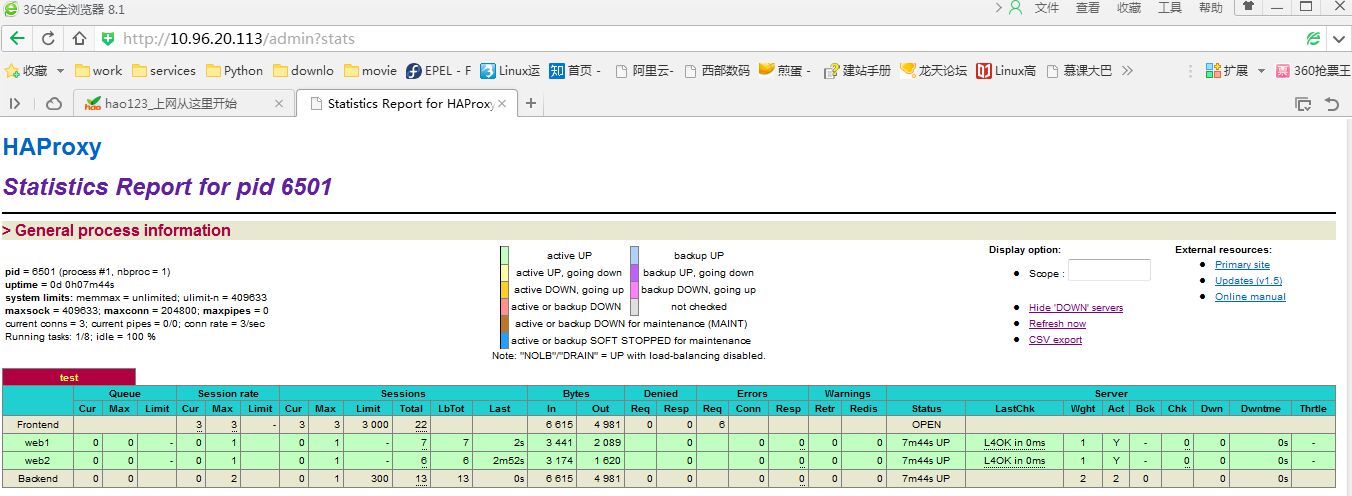haproxy是一个开源的、高性能的基于tcp和http应用代理的HA的、LB服务软件,它支持双机热备、HA、LB、虚拟主机、图形界面查看状态信息等功能,其配置简单、维护方便,而且后端RS的health check功能有很好的支持(相当于keepalived的health check),当它代理的后端RS server故障时,haproxy会自动将该server移除,当故障的RS server恢复后,还会自动加入进来继续提供服务;
与nginx比,haproxy没有web server功能,只能用于代理,特别适用于高负载、访问量大,需要会话保持(LVS的-p和nginx的iphash会导致负载不均;haproxy会在会话中插入cookie用以保持会话)及七层应用代理的业务;
haproxy运行在当下普通的server上,不需优化就可支持数以万计的并发连接,并且它的运行模式使得它可以很简单、轻松、安全的整合到各种已有的网站架构中,同时它的代理模式可使所有应用服务器不暴露到公网上(也即它背后的node server不需公网IP);
frontend(可用acl规则匹配,让运维管理人员根据任意HTTP请求头内容做规则匹配,然后把请求定向到相关的backend);
backend(定义多个RS server pools,frontend把请求转过来交给此处定义的RS server处理);
通过frontend和backend可很容易的实现各种七层应用代理功能;
haproxy支持两种主要代理模式:
基于4层的tcp协议族应用代理(haproxy仅在client和server-side之间进行流量转发,如邮件服务、内部协议通信server、MySQL、https等);
基于7层的http应用代理(haproxy会分析应用层协议,通过允许、拒绝、交换、增加、修改、删除request请求或response回应指定内容来控制协议);
注:haproxy软件采用的是类NAT模式(与LVS的NAT模式本质不同),数据包来去都会经过haproxy,因此在流量特别大时(尤其门户网站),其效率不如LVS的DR模式,在一般的中小型公司(千万级PV以下)建议使用haproxy做LB,对于负责运维的管理人员来说配置简单、快速、维护方便,出问题好排查(运维使用软件的原则:简单、易用、高效);
注:
架构中L4和L7的位置;
haproxy软件的4层tcp应用代理非常优秀,配置比LVS和nginx简单、方便(不需要RS端做任何特殊配置,只要对应服务开启就可实现应用代理;配置语法和增加虚拟主机等功能要比LVS和nginx容易;而且和商业版的NetScaler(Citrix)、BIG-IP(F5)、Thunder系列(A10)等LB硬件设备在架构中的位置和使用方法一模一样);
haproxy的最大优势在于对7层的URL请求头应用过滤的功能及session功能,在门户网站的高并发生产架构中,haproxy的位置一般在4层LVS LB的下面,如官方推荐的也可在硬件LB器下使用,其表现非常好,09年taobao、jd的业务也大面积使用了haproxy作为7层cache应用代理
准备环境:
proxy-1-1(eth0:10.96.20.113,eth1:172.16.10.113)
proxy-1-2(eth0:10.96.20.114,eth1:172.16.10.114)
RS1(eth0:172.16.10.118)
RS2(eth0:172.16.10.119)
[root@proxy-1-1 ~]# cat /etc/redhat-release
Red Hat Enterprise Linux Server release 6.5(Santiago)
[root@proxy-1-1 ~]# uname -rm
2.6.32-642.3.1.el6.x86_64 x86_64
[root@proxy-1-1 ~]# vim /etc/sysctl.conf
net.ipv4.ip_forward = 1
[root@proxy-1-1 ~]# sysctl -p
net.ipv4.ip_forward = 1
net.ipv4.conf.default.rp_filter = 1
net.ipv4.conf.default.accept_source_route =0
kernel.sysrq = 0
kernel.core_uses_pid = 1
net.ipv4.tcp_syncookies = 1
error:"net.bridge.bridge-nf-call-ip6tables" is an unknown key
error: "net.bridge.bridge-nf-call-iptables"is an unknown key
error:"net.bridge.bridge-nf-call-arptables" is an unknown key
kernel.msgmnb = 65536
kernel.msgmax = 65536
kernel.shmmax = 68719476736
kernel.shmall = 4294967296
[root@proxy-1-1 haproxy]# elinks -dump http://172.16.10.118
RS1
[root@proxy-1-1 haproxy]# elinks -dump http://172.16.10.119
RS2
[root@proxy-1-1 ~]# yum -y install haproxy
[root@proxy-1-1 ~]# rpm -ql haproxy
/etc/haproxy
/etc/haproxy/haproxy.cfg
/etc/logrotate.d/haproxy
/etc/rc.d/init.d/haproxy
/etc/sysconfig/haproxy
/usr/bin/halog
/usr/bin/iprange
/usr/sbin/haproxy
/usr/share/doc/haproxy-1.5.4
/usr/share/doc/haproxy-1.5.4/CHANGELOG
……
[root@proxy-1-1 ~]# id haproxy
uid=188(haproxy) gid=188(haproxy)groups=188(haproxy)
[root@proxy-1-1 ~]# haproxy -h #(-sf可用于平滑重启)
HA-Proxy version 1.5.4 2014/09/02
Copyright 2000-2014 Willy Tarreau<w@1wt.eu>
Usage : haproxy [-f <cfgfile>]* [ -vdVD ] [ -n <maxconn> ] [ -N <maxpconn> ]
[ -p <pidfile> ] [ -m <max megs> ] [ -C <dir> ]
-v displays version ; -vv shows known build options.
-d enters debug mode ; -db only disables background mode.
-dM[<byte>] poisons memory with <byte> (defaults to 0x50)
-V enters verbose mode (disables quiet mode)
-D goes daemon ; -C changes to<dir> before loading files.
-q quiet mode : don't display messages
-c check mode : only check config filesand exit
-n sets the maximum total # of connections (2000)
-m limits the usable amount of memory (in MB)
-N sets the default, per-proxy maximum # of connections (2000)
-L set local peer name (default to hostname)
-p writes pids of all children to this file
-de disables epoll() usage even when available
-dp disables poll() usage even when available
-dS disables splice usage (broken on old kernels)
-dV disables SSL verify on servers side
-sf/-st [pid ]* finishes/terminates oldpids. Must be last arguments.
[root@proxy-1-1 ~]# cd /etc/haproxy/
[root@proxy-1-1 haproxy]# mv haproxy.cfg haproxy.cfg.ori
[root@proxy-1-1 haproxy]# egrep -v "#|^$" haproxy.cfg.ori > haproxy.cfg
[root@proxy-1-1 haproxy]# vim haproxy.cfg
global
log 127.0.0.1:514local0 info #(info会记录访问日志,生产中不要用,要用warning或error)
chroot /var/lib/haproxy
pidfile /var/run/haproxy.pid
maxconn 204800 #(定义每个haproxy进程的最大连接数,每个连接包括client和server-side,所以单个tcp会话最大数目是该值的两倍)
user haproxy
group haproxy
daemon
stats socket /var/lib/haproxy/stats
spread-checks 3
#tune.maxaccept 100
#tune.maxpollevents 180
#nbproc 8 #(设置haproxy启动时的进程数,最好与cpu数相同)
defaults
mode http #(语法:mode http|tcp|health)
log global
option httplog
option dontlognull
option http-server-close
option forwardfor except 127.0.0.0/8
option redispatch
retries 3
timeout http-request 10s
timeout queue 1m
timeout connect 10s #(设置成功连接到一台server的最长等待时间,默认单位ms可省,若非默认要跟单位,旧版本为contimeout)
timeout client 1m #(设置连接client发送数据时的成功连接最长等待时间,旧版本为clitimeout)
timeout server 1m #(设置服务端回应client数据发送的最长等待时间,旧版为srvtimeout)
timeout http-keep-alive 10s
timeout check 10s
maxconn 3000
listen test
bind *:80
mode http
no option splice-response
stats enable
stats hide-version
stats uri /admin?stats
stats auth admin:admin
balance roundrobin
option httpclose
option forwardfor
#option httpchk HEAD /check.html HTTP/1.0
timeout connect 15s
timeout server 15s
server web1 172.16.10.118:80 check
server web2 172.16.10.119:80 check
[root@proxy-1-1 haproxy]# vim /etc/rsyslog.conf
$ModLoad imudp
$UDPServerRun 514
local0.* /var/log/haproxy.log
[root@proxy-1-1 haproxy]# vim /etc/sysconfig/rsyslog
SYSLOGD_OPTIONS="-c2 -m 0 -r -x"
[root@proxy-1-1 haproxy]# service rsyslog restart
Shutting down system logger: [ OK ]
Starting system logger: [ OK ]
[root@proxy-1-1 haproxy]# lsof -i :514
COMMAND PID USER FD TYPE DEVICE SIZE/OFF NODE NAME
rsyslogd 6526 root 3u IPv4 81287 0t0 UDP *:syslog
rsyslogd 6526 root 4u IPv6 81288 0t0 UDP *:syslog
[root@proxy-1-1 haproxy]# ps aux | grepsyslog
root 6526 0.0 0.7 267752 1616 ? Sl 22:00 0:00 /sbin/rsyslogd -i /var/run/syslogd.pid -c 2 -m 0 -r -x
root 6535 0.0 0.3 103264 836 pts/0 S+ 22:00 0:00 grep syslog
[root@proxy-1-1 haproxy]# haproxy -c -f haproxy.cfg
Configuration file is valid
[root@proxy-1-1 haproxy]# service haproxy start
Starting haproxy: [ OK ]
[root@proxy-1-1 haproxy]# chkconfig --list rsyslog
rsyslog 0:off 1:off 2:on 3:on 4:on 5:on 6:off
[root@proxy-1-1 haproxy]# chkconfig haproxy on
[root@proxy-1-1 haproxy]# chkconfig --list haproxy
haproxy 0:off 1:off 2:on 3:on 4:on 5:on 6:off
[root@proxy-1-1 haproxy]# netstat -tnulp | grep :80
tcp 0 0 0.0.0.0:80 0.0.0.0:* LISTEN 6501/haproxy
[root@proxy-1-1 haproxy]# ps aux | grep haproxy
haproxy 6501 0.0 0.6 70696 1428 ? Ss 21:58 0:00 /usr/sbin/haproxy -D-f /etc/haproxy/haproxy.cfg -p /var/run/haproxy.pid
root 6551 0.0 0.3 103264 828 pts/0 S+ 22:01 0:00 grep haproxy
[root@proxy-1-1 haproxy]# tail /var/log/haproxy.log
Aug 14 22:02:29 127.0.0.1 haproxy[6501]:10.96.20.89:6109 [14/Aug/2016:22:02:29.645] test test/web2 0/0/1/0/1 200 270 -- ---- 2/2/0/0/0 0/0 "GET / HTTP/1.1"
Aug 14 22:03:12 127.0.0.1 haproxy[6501]:10.96.20.89:6114 [14/Aug/2016:22:03:12.597] test test/web1 1/0/0/1/2 200 270 -- ---- 2/2/0/0/0 0/0 "GET / HTTP/1.1"
#for i in {1..10} ; do curl 10.96.20.113;sleep 2; done #(单独找一台主机测试当前算法)
haproxy多种health check方法:
1、基于tcp的health check,haproxy只会去检查RS上服务对应的port,这并不能保证服务的完全可用,但这可作为辅助的检查手段,若不是非常严格的业务环境可用此种,keepalived向下的health check就是基于port
server web1 172.16.10.118:80 check port 80 inter 5000 fall 5
注:
check port 80(表示对80port进行health check,可简写为check)
2、基于ip的http uri方式的health check:
option httpchk HEAD /check.html HTTP/1.0
语法:option httpchk METH URI VER
method有:GET和HEAD,GET相当于#wget http://10.96.20.113/check.html,HEAD相当于#curl -I http://10.96.20.113/check.html;
URI(站点目录下有check.html,此文件由开发提供)
3、基于域名的URL的health check:
option httpchk HEAD /index.jsp HTTP/1.1\r\nHost:test.51cto.com
注:测试时需要在RS上配置基于域名的vhost,并创建index.jsp测试页面,此文件只要存在haproxy能检测到则显示正常,适用于更精细的基于具体业务的检测需求
注:其它服务的health check:
option smtpchk -> sends "HELO localhost"
option smtpchk EHLO mail.mydomain.com -> sends this ESMTP greeting
option ldap-check
option mysql-check [user USERNAME]
语法:
server <name> <address>[:port] [settings ...]
default-server [settings ...]
settings有:
check
inter <delay>(interval间隔,表示每5秒检查一次)
fall <count>(失败5次,仍有问题将其摘除)
rise <count>(检查后端RS共2次若正常,则将其加入进来)
weight <weight>
backup(高可用参数,仅当其它所有RS都挂掉有此参数的备机才启用;当有多个备机,可用option allbackups,当其它所有RS都挂掉,所有备机全部启用;最理想的情况是,有一个nomal RS server故障就启用一个备机,而不是等所有nomal RS server全部挂掉才启用备机,解决办法,使用acl做判断)
maxconn <maxconn>
maxqueue <maxqueue>
cookie <value>
注:
若结尾无inter 2000 fall 3,则按默认每2s检查一次共3次;
nginx中的upstream段中也有类似的配置;max_fails=2,最大尝试失败次数,默认为1,0表示禁止失败尝试;fail_timeout=2;
七层架构中,相对于server,越靠外(离用户近)health check次数越多(例如:CDN提供商蓝汛10次);越靠内(server自身)health check次数越少,提升用户体验,按2s检查一次共3次,则要耗费6s才能把出问题的RS踢掉;
举例:
option allbackups
server web7 172.16.10.7:80 check port 80 inter 5000 fall 5 backup
server web8 172.16.10.8:80 check port 80 inter 5000 fall 5 backup
基于域名中的指定字串做7层跳转(在frontend段中使用acl做更精细的转发):
语法:
acl <aclname> <criterion> [flags] [operator] [<value>] ...
注:frontend段中,acl先定义好规则,再用use_backend或default_backend对规则进行处理;hdr(host),hdr_beg(host),begin;-i,ignorecase;
举例:
acl www_domain hdr(host)-i www.test.com
acl blog_domain hdr(host)-i blog.test.com
也可写成:
acl www_domain hdr_beg(host) -i www.
acl blog_domain hdr_beg(host) -i blog.
将后端两个RS做成基于域名的虚拟主机:
[root@proxy-1-1 haproxy]# vim /etc/hosts
[root@proxy-1-1 haproxy]# elinks -dump www.test.com
www.test.com
[root@proxy-1-1 haproxy]# elinks -dump blog.test.com
blog.test.com
[root@proxy-1-1 haproxy]# elinks -dump 172.16.10.118
www.test.com
[root@proxy-1-1 haproxy]# elinks -dump 172.16.10.119
blog.test.com
[root@proxy-1-1 haproxy]# vim haproxy.cfg
global
log 127.0.0.1:514 local0 info
chroot /var/lib/haproxy
pidfile /var/run/haproxy.pid
maxconn 204800
user haproxy
group haproxy
daemon
stats socket /var/lib/haproxy/stats
spread-checks3
#tune.maxaccept 100
#tune.maxpollevents 180
#nbproc 8
defaults
mode http
log global
option httplog
option dontlognull
option http-server-close
option forwardfor except 127.0.0.0/8
option redispatch
retries 3
timeout http-request 10s
timeout queue 1m
timeout connect 10s
timeout client 1m
timeout server 1m
timeout http-keep-alive 10s
timeout check 10s
maxconn 3000
frontend test
bind*:80
mode http
stats enable
stats hide-version
stats uri /admin?stats
stats authadmin:admin
acl www_domain hdr(host)-i www.test.com
acl blog_domain hdr(host)-i blog.test.com
use_backend www if www_domain
use_backend blogif blog_domain
default_backend www
backend www
balance leastconn
option httpclose
option forwardfor
server web1 172.16.10.118:80 check port 80 inter 1000 fall 1
backend blog
balance leastconn
option httpclose
option forwardfor
server web1 172.16.10.119:80 check port 80 inter 1000 fall 1
[root@proxy-1-1 haproxy]# haproxy -c -f haproxy.cfg
Configuration file is valid
[root@proxy-1-1 haproxy]# service haproxy restart
Stopping haproxy: [ OK ]
Starting haproxy: [ OK ]
在win的HOSTS文件加入:10.96.20.113 www.test.com blog.test.com
ctrl+F5强制刷新后依然
基于url地址目录做7层跳转:
acl static_test path_beg /nginx/
acl dynamic_test path_beg /php/
注:例如在访问www.test.com/nginx/时交至后端nginxpools处理;访问www.test.com/php/时交至后端phppools处理
[root@proxy-1-1 haproxy]# vim haproxy.cfg
global
……
defaults
……
frontend test
bind *:80
mode http
stats enable
stats hide-version
stats uri /admin?stats
stats auth admin:admin
acl static_test path_beg /nginx/
acl dynamic_test path_beg /php/
use_backend www if static_test
use_backend blog if dynamic_test
default_backend www
backend www
balance leastconn
option httpclose
option forwardfor
server web1 172.16.10.118:80 check port 80 inter 1000 fall 1
backend blog
balance leastconn
option httpclose
option forwardfor
server web1 172.16.10.118:80 check port 80 inter 1000 fall 1
[root@proxy-1-1 haproxy]# haproxy -c -f haproxy.cfg
Configuration file is valid
[root@proxy-1-1 haproxy]# service haproxy restart
Stopping haproxy: [ OK ]
Starting haproxy: [ OK ]
注:在RS上创建相应的目录及文件
基于文件扩展名的7层跳转:
acl pic_test path_end .gif .png .jpg .css .js
也可写成:
acl pic_test path_end \.(gif|png|jpg|css?.*|js?.*)$
注:生产中通常,首页index.html用一组server;php、java等动态内容用一组server;js、css等静态内容用一组server;图片用一组server;通常打开网页是由多组server共同完成
[root@proxy-1-1 haproxy]# vim haproxy.cfg
……
frontend test
bind *:80
mode http
stats enable
stats hide-version
stats uri /admin?stats
stats auth admin:admin
acl pic_test path_end .gif .png .jpg .css .js
acl static_test path_beg /nginx/
acl dynamic_test path_beg /php/
use_backend www if pic_test
use_backend www if static_test
use_backend blog if dynamic_test
default_backend www
backend www
balance leastconn
option httpclose
option forwardfor
server web1 172.16.10.118:80 check port 80 inter 1000 fall 1
backend blog
balance leastconn
option httpclose
option forwardfor
server web1 172.16.10.118:80 check port 80 inter 1000 fall 1
[root@proxy-1-1 haproxy]# haproxy -c -f haproxy.cfg
Configuration file is valid
[root@proxy-1-1 haproxy]# service haproxy restart
Stopping haproxy: [ OK ]
Starting haproxy: [ OK ]
注:在RS-side上传图片
测试:
基于user-aggent做7层跳转:
acl iphone_users hdr_sub(user-agent) -i iphone
redirect prefix http://3g-iphone.test.com if iphone_users
acl android_users hdr_sub(user-agent) -i android
redirect prefix http://3g-android.test.com if android_users
注:本地要设置跳转后的地址页面;nginx中"$http_user_agent";httpd中\"%{user-agent}i\";
[root@proxy-1-1 haproxy]# vim haproxy.cfg
……
frontend test
bind *:80
mode http
stats enable
stats hide-version
stats uri /admin?stats
stats auth admin:admin
acl iphone_users hdr_sub(user-agent) -i iphone
redirect prefix http://3g-iphone.test.com if iphone_users
acl android_users hdr_sub(user-agent) -i android
redirect prefix http://3g-android.test.com if android_users
acl pic_test path_end \.(gif|png|jpg|css?.*|js?.*)$
acl static_test path_beg /nginx/
acl dynamic_test path_beg /php/
use_backend www if pic_test
use_backend www if static_test
use_backend blog if dynamic_test
default_backend www
backend www
balance leastconn
option httpclose
option forwardfor
server web1 172.16.10.118:80 check port 80 inter 1000 fall 1
backend blog
balance leastconn
option httpclose
option forwardfor
server web1 172.16.10.118:80 check port 80 inter 1000 fall 1
基于ip和port的访问控制:
frontend test
……
acl valid_ip src 10.96.20.0/24
http-request deny if ! valid_ip
注:1.5版本不能使用block取而代之的是http-request deny,将不符合指定网段内的client访问时报403 Forbidden;七层应用的匹配顺序是根据haproxy.cfg配置文件中frontend段中use_backend书写的先后顺序依次匹配,listen、frontend、backend中有的优先于defaults段中的
错误页面优雅显示(不支持404,status code 404 not handled,error relocation will be ignored):
语法:
errorfile <code> <file>
Example :
errorfile 400 /etc/haproxy/errorfiles/400badreq.http
errorfile 408 /dev/null # workaround Chrome pre-connect bug
errorfile 403 /etc/haproxy/errorfiles/403forbid.http
errorfile 503 /etc/haproxy/errorfiles/503sorry.http
errorloc <code> <url>
errorloc302 <code> <url>
errorloc303 <code> <url>
语法:
balance <algorithm> [ <arguments> ]
algorithm有:roundrobin,static-rr,leastconn,first,source,uri,url_param,hdr(<name>),rdp-cookie(<name>)
让后端RS记录前端访问的真实IP:
[root@proxy-1-1 haproxy]# vim haproxy.cfg
listen test
option forwardfor
[root@proxy-1-1 haproxy]# service haproxy restart
Stopping haproxy: [ OK ]
Starting haproxy: [ OK ]
[root@localhost ~]# vim /etc/httpd/conf/httpd.conf
LogFormat "\"%{X-Forwarded-For}i\" %l %u %t \"%r\" %>s %b" common
CustomLog logs/access_log common
[root@localhost ~]# service httpd restart
Stopping httpd: [ OK ]
Starting httpd: httpd: Could not reliably determine the server's fully qualified domain name, using localhost.localdomain for ServerName
[ OK ]
[root@localhost ~]# tail /etc/httpd/logs/access_log #(在win上访问,查看RS日志,之前记录的一直是代理server的172.16.10.113,之后记录的是win主机上的IP)
172.16.10.113 - - [14/Aug/2016:20:36:30 -0700] "GET / HTTP/1.1" 200 4 "-" "curl/7.19.7 (x86_64-redhat-linux-gnu) libcurl/7.19.7 NSS/3.14.3.0 zlib/1.2.3 libidn/1.18 libssh2/1.4.2"
172.16.10.113 - - [14/Aug/2016:20:36:30 -0700] "GET / HTTP/1.1" 200 4 "-" "curl/7.19.7 (x86_64-redhat-linux-gnu) libcurl/7.19.7 NSS/3.14.3.0 zlib/1.2.3 libidn/1.18 libssh2/1.4.2"
……
"-" - - [15/Aug/2016:01:22:46 -0700] "HEAD /check.html HTTP/1.0" 200 -
"10.96.20.89" - - [15/Aug/2016:01:22:47 -0700] "GET / HTTP/1.1" 200 4
"10.96.20.89" - - [15/Aug/2016:01:22:48 -0700] "GET / HTTP/1.1" 200 4
"-" - - [15/Aug/2016:01:22:51 -0700] "HEAD /check.html HTTP/1.0" 200 -
heartbeat+haproxy:
主备模式(heartbeat仅负责VIP飘移,两台server上haproxy配置相同,listen段绑定VIP,事先把haproxy启动);
[root@proxy-1-1 haproxy]# vim /etc/ha.d/haresources
proxy-1-1 IPaddr::10.96.20.8/24/eth0
[root@proxy-1-1 haproxy]# vim haproxy.cfg
listen test
bind 10.96.20.8:80
主主模式(heartbeat仅负责两VIP飘移,两台server上haproxy配置相同,有两段listen配置,分别绑定两个VIP,事先把haproxy启动);
[root@proxy-1-1 haproxy]# vim /etc/ha.d/haresources
proxy-1-1 IPaddr::10.96.20.8/24/eth0
proxy-1-2 IPaddr::10.96.20.9/24/eth0
[root@proxy-1-1 haproxy]# vim haproxy.cfg
listen test1
bind 10.96.20.8:80
……
listen test2
bind 10.96.20.9:80
……
常见的HTTP状态码:
200-OK(standard response for successful HTTP requests),服务成功返回网页;
301-Moved Permanently(this and all future requests should be directedto the given)永久跳转,请求的网页已永久跳转到新位置;
403-Forbidden(forbidden request(matches a deny filter),HTTP403;the request was a legal request,but the server is refusing to respond to it)禁止访问,服务拒绝请求;
404-Not Found(thre requested resource could not be found but may be available again in the future)服务器找不到请求的页面;
500-Internal Server Error(internal error in haproxy,HTTP500;a generic error message,given when no more specific message is suitable)内部服务器错误;
502-Bad Gateway(the server returned an invalid or in complete response,HTTP502,the server was acting as a gateway or proxy and received an invalid response from the upstream server)网关错误,一般是网关服务器请求后端时,后端服务器没有按HTTP协议返回正确结果;
503-Service Unavailable(no server was available to handle the request,HTTP503;the server is currently unavailable,because it is overloaded or down for maintenance)服务当前不可用,可能因为超载或停机维护;
504-Gateway Timeout(the server failed to reply in time,HTTP504;the server was acting as a gateway or proxy and did not receive a timely response from the upstream server)网关超时,一般是网关服务器请求后端时,后端服务器没有在指定时间内完成服务;
代码、软件在LB器(LVS、nginx、haproxy)层面上实现平滑上线:
后端RS分A、B两组;
LVS(通过命令ipvsadm -d -t|-u SERVICE_ADDRESS -r SERVER_ADDRESS;也可通过替换配置文件,但LVS没有平滑重启的方式);
nginx和haproxy(替换配置文件,#service nginx|haproxy reload达到平滑重启);
DB更新(改配置时>SET GLOBAL ……;同时改配置文件);
运维应关注两点:全网数据、7*24h不间断服务
全网数据备份解决方案:
1、数据库数据:
主从,仅在server物理故障时恢复,若手动drop误删则无法恢复,解决办法:备机开binlog保持1天以上,并按天做备份;
案例(baidu,一主多从,其中一个从不提供服务,专门做备份,半同步插件或drbd做到实时同步,事务提交)
2、图片资源:
全量(drbd;通过程序实现双写,提交数据时写到两个存储上;分布式存储nosql、MySQL、mongodb同步机制做存储;分布式架构方案);
增量(rsync,小文件比对时间很长;drbd,浪费资源,备node不可用;按时间增量,按月每月一个目录,如201607、201608;更新资源写LOG,rsync根据LOG直接同步变化的数据;inotify、sersync等)
3、程序、各配置文件都要放到SVN里,再向外发布,办公室SVN-->IDC测试-->IDC正式,关键要维护好SVN
注:需求分析(对每个项目都要事先写好备份规划,根据需求讨论最多可承受丢多长时间的数据;数据库、存储备份、测试数据)
7*24h不间断服务:
集群(LB(LVS、nginx、haproxy、BIG-IP、NetScaler)、HA(keepalived、heartbeat))
性能、扩展(优化、用户体验要好,业务易扩展)
监控(运维级别,业务级别(按产品线监控、流量、负载、访问、请求、错误日志、接口)
注:QPS每秒请求量、RT反馈时间,三个层面监控(基础监控-->应用监控-->业务层面监控)
本文转自 chaijowin 51CTO博客,原文链接:http://blog.51cto.com/jowin/1840986,如需转载请自行联系原作者



















